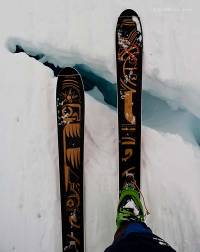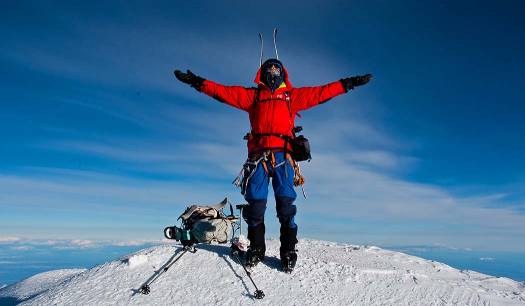
SkiTheBig3, the right gear helped it happen.
Gear we choose for human powered backcountry mountaineering is extremely important, especially when you attempt to ski the “family” peaks (Denali, Hunter, Foraker) of the Alaska Range during one expedition. In my choices I prioritize three things: durability, lightness, and ease of use. Selecting gear for SkiTheBig3 was an in-depth process.
Skis:
My ski of choice was the Liberty Variant 97, the smallest touring specific ski of the Colorado company based in Avon. It is certainly not the lightest ski out there, but coming from a racing background, I usually don’t like the very light skis that others rave about. Variant 97 was the perfect mix of skiing performance and weight. I don’t mind carrying more weight up if the ski will withstand what I demand on the way down, namely nailing turns above huge exposure. Variant 97 has a very slight tip rise, normal camber and sidecut. This makes it perform on hard pack, and also allows you to enjoy the pow (which we didn’t get much of). The Variant also has a nice flat tail to make the kick turns easier as well as a notch to keep those skins on a little better. I had the Dynafit FT 12 binding on it. Lou has more than enough on Dynafit bindings here, so I won’t go into them except to say that I have used them for years, and will continue to do so.
Boots:
I was quite indecisive about which boot to bring on the trip. I usually use the Dynafit Vulcan, but I thought I might want something lighter. I ended up going with the trusty Vulcan and I was not disappointed. I did go one size bigger than what I normally use to combat the extreme cold we expected to find. A larger boot has more room which makes the blood circulate to the foot easier, which keeps your feet warmer, and you happier. By doing this I sacrificed some performance — better that than toes though. In the Vulcan I had an Intuition Pro Tour liner, a thick warm liner that is also somewhat stiff. With my own orthotic and a Booster strap I was very happy with my setup.
Black Diamond Sabertooth Pro Crampon has been what I have used for years. It’s perfect for glacier travel and performed well when we needed to climb vertical ice on Mt. Hunter. They are super easy to put on even with my big mittens.
On summit days I wore 40 Below overboots. They were a lifesaver, keeping my feet super warm while still being able to work with Dynafits and crampons (after some mods).
Clothing:
The temperature swings on a glacier in Alaska are amazing. During the day it can feel downright tropical with the sun reflecting off the immense white glacier. The temps once the sun goes down drop incredibly fast. Due to these extremes, clothing on a trip into the Alaska Range is super critical.
For my outerwear shells I used the Eider Conquest jacket and pants. These are very light three layer GORE-TEX® shells that I have used quite a bit. The pants have a full side zipper which makes layering on the fly easy. They also have Kevlar® reinforced cuffs to protect from the dreaded crampon leg stab. The jacket has pockets conveniently placed to get to while wearing a pack. Same for the pit zips. The hood is also big enough to fit over a helmet comfortably, necessary for the blowing wind.
I also went with Eider for a mid layer down jacket. The Belladone is awesome. Probably my favorite piece of clothing I had on the trip. With a down hood, front and back panels it kept me super warm. The sides are made of a light fleece that allowed it to breathe very well. I probably had this jacket on for 80% of my waking hours. (Note: Eider no longer makes the Belladone, but has come out with something even better: The Blow Alpha.)
Fleece mid layers went to Eider as well. The wonder hoodie lived up to its name. Hooded mid layers are huge in my book. Flipping that light hood over my ears when the wind picks up is key.
For the heavy down I had Millet Expedition jacket and pants. These are quite possibly the warmest things I have ever worn. For cold nights in camp I could not have asked for more. With reinforced elbows, knees, and seat, these are nice and burly as well, but still can pack down relatively small. This was all I had on Hunter during our “shiver bivy”. My shivering was less than I would have expected thanks to them.
For base layers it’s all about the wool. I had a mix of different brands. Smartwool, Minus 33, and some others that are so old I don’t even remember what they are. When living in close quarters for so long wool is imperative. The stink common with synthetics could turn into an expedition ender.
Booties:
Down booties are amazing pieces of gear. Having good ones can make or break a trip. All of us went with the Western Mountaineering Down Booties. They are super warm and come up over the calf to keep snow out while stumbling around in a wind storm trying to collect snow for water. The seams tend to lose down easily, but some Aquaseal stops that problem easily.
Gloves:
Gloves are important. Frozen fingers can render you worthless. I had a pair of Eider liner gloves, my trusty Kinkos with Snow Seal Waterproofing (2 pairs), and some Black Diamond Mercury mitts for when the mercury dropped.
Head:
For eyewear I only wore my Julbo Explorer Glacier glasses. Nice dark lenses and full wrap around coverage made my eyes happy. I had some googles, but only broke them out once, and then put them away once they fogged so much I couldn’t see anything.
A couple beanies, some Buffs, a bandana, and a Ski Arpa trucker hat rounded out my head gear.
Sleeping Gear:
My bag was the Millet 7 Summits. I think this bag is more suited for dryer climates (the Alaska Range is very moist). The shell is quite thin, which made it super light, but also didn’t keep the moisture out well. It dried very fast every day, so I never had an issue. The lightweight factor was super nice with all the gear we had on our backs every day.
Whenever we were on the Kahiltna Glacier I used a Therm-a-rest Prolite pad with a closed cell foam pad underneath. While at high camps on Hunter and Foraker I only had the Prolite and it worked fine alone. I was quite jealous of Aaron’s Therm-a-rest NeoAir though. That will be what I use from now on.
Backpack:
My pack was the Millet UBIC 60. I could have used a slightly bigger bag, but somehow I was able to fit all the gear that I needed. It has a unique strap system that is able to hold a lot of gear on the outside of the pack. Usually I don’t like the gypsy wagon pack style, but this worked quite well for me. There was simply too much gear to fit in our packs. At some point we all did it.
WildSnow.com guest blogger Anton Sponar spends winters enjoying the Aspen area of Colorado, while summers are taken up with slave labor doing snowcat powder guiding at Ski Arpa in Chile. If Anton didn’t ski every month and nearly every week of the year, skiing would cease to exist as we know it.


